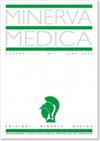中年妇女亚临床动脉粥样硬化和微量白蛋白尿的预测因素:一项横断面研究。
IF 4.7
4区 医学
0 MEDICINE, GENERAL & INTERNAL
引用次数: 1
摘要
背景:心血管疾病在女性中越来越受到关注。目的是评估临床和人体测量测量在亚临床动脉粥样硬化发展中的作用。方法通过横断面研究203例欧洲女性颈动脉内膜-中膜厚度异常(CIMT)的发生率及相关临床参数。结果研究人群平均年龄为38.3±5.4岁,中位体重指数为29.25 (IQR 25.06 ~ 36.11) Kg/m2,中位腰围指数(WI)为1.15 (IQR 1.06 ~ 1.34)。有169名(83.25%)参与者出现CIMT升高。线性回归分析显示WI是CIMT增加的唯一预测因子(β=24.387, p<0.001)。事后ROC分析显示,WI为1.12预测CIMT增加的敏感性为62%,特异性为53% (AUC 0.63, 95% CI 0.55-0.72, p=0.016)。尿白蛋白肌酐比值(ACR)中位数为4.4mg/g,微量白蛋白尿患病率为8.9%;血清甘油三酯是ACR的唯一独立预测因子。结论动脉粥样硬化在中年妇女中非常普遍,可以通过异常的CIMT检测到。腰围指数是当代绝经前女性亚临床动脉粥样硬化的主要预测指标。1.12的WI在预测该患者人群是否存在动脉粥样硬化方面具有较好的敏感性和特异性。本文章由计算机程序翻译,如有差异,请以英文原文为准。
Predictors of subclinical atherosclerosis and microalbuminuria in middle-aged women: a cross-sectional study.
BACKGROUND
Cardiovascular disease is of increasing concern in women. The aim was to assess the role of clinical and anthropometric measures in the development of subclinical atherosclerosis.
METHODS
A cross-sectional study in 203 Europid females to determine the prevalence of abnormal carotid intima-media thickness (CIMT) and associated clinical parameters.
RESULTS
The study population had a mean age of the 38.3±5.4 years, a median body mass index of 29.25 (IQR 25.06-36.11) Kg/m2 and median waist index (WI) of 1.15 (IQR 1.06-1.34). Increased CIMT was present in 169 (83.25%) participants. Linear regression analysis revealed WI to be the sole predictor of increased CIMT (β=24.387, p<0.001). Post-hoc ROC analysis revealed a WI of 1.12 has 62% sensitivity and 53% specificity for predicting increased CIMT (AUC 0.63, 95% CI 0.55-0.72, p=0.016). The median urinary albumincreatinine ratio (ACR) was 4.4mg/g and the prevalence of microalbuminuria was 8.9%; serum triglycerides were the only independent predictor of ACR.
CONCLUSIONS
Atherosclerosis, as detected by abnormal CIMT, is very prevalent in middleaged women. Waist index is the major predictor of subclinical atherosclerosis in a contemporary premenopausal female population. A WI of 1.12 exhibits relatively good sensitivity & specificity in predicting the presence of atherosclerosis in this patient population.
求助全文
通过发布文献求助,成功后即可免费获取论文全文。
去求助
来源期刊

Minerva medica
医学-医学:内科
CiteScore
6.40
自引率
6.40%
发文量
358
审稿时长
>12 weeks
期刊介绍:
Minerva Medica publishes scientific papers on internal medicine. Manuscripts may be submitted in the form of editorials, original articles, review articles, case reports, special articles, letters to the Editor and guidelines. The journal aims to provide its readers with papers of the highest quality and impact through a process of careful peer review and editorial work. Duties and responsibilities of all the subjects involved in the editorial process are summarized at Publication ethics.
 求助内容:
求助内容: 应助结果提醒方式:
应助结果提醒方式:


